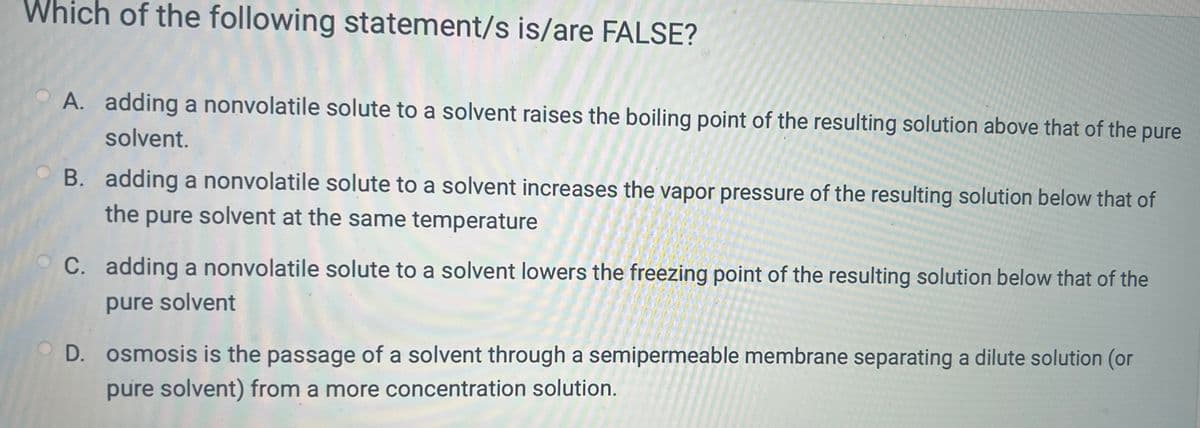Which of the following statement/s is/are FALSE? A. adding a nonvolatile solute to a solvent raises the boiling point of the resulting solution above that of the pure solvent. B. adding a nonvolatile solute to a solvent increases the vapor pressure of the resulting solution below that of the pure solvent at the same temperature C. adding a nonvolatile solute to a solvent lowers the freezing point of the resulting solution below that of the pure solvent D. osmosis is the passage of a solvent through a semipermeable membrane separating a dilute solution (or pure solvent) from a more concentration solution.
Which of the following statement/s is/are FALSE? A. adding a nonvolatile solute to a solvent raises the boiling point of the resulting solution above that of the pure solvent. B. adding a nonvolatile solute to a solvent increases the vapor pressure of the resulting solution below that of the pure solvent at the same temperature C. adding a nonvolatile solute to a solvent lowers the freezing point of the resulting solution below that of the pure solvent D. osmosis is the passage of a solvent through a semipermeable membrane separating a dilute solution (or pure solvent) from a more concentration solution.
Chemistry
10th Edition
ISBN:9781305957404
Author:Steven S. Zumdahl, Susan A. Zumdahl, Donald J. DeCoste
Publisher:Steven S. Zumdahl, Susan A. Zumdahl, Donald J. DeCoste
Chapter11: Properties Of Solutions
Section: Chapter Questions
Problem 27Q
Related questions
Question

Transcribed Image Text:Which of the following statement/s is/are FALSE?
A. adding a nonvolatile solute to a solvent raises the boiling point of the resulting solution above that of the pure
solvent.
B. adding a nonvolatile solute to a solvent increases the vapor pressure of the resulting solution below that of
the pure solvent at the same temperature
C. adding a nonvolatile solute to a solvent lowers the freezing point of the resulting solution below that of the
pure solvent
D. osmosis is the passage of a solvent through a semipermeable membrane separating a dilute solution (or
pure solvent) from a more concentration solution.
Expert Solution
This question has been solved!
Explore an expertly crafted, step-by-step solution for a thorough understanding of key concepts.
Step by step
Solved in 3 steps

Knowledge Booster
Learn more about
Need a deep-dive on the concept behind this application? Look no further. Learn more about this topic, chemistry and related others by exploring similar questions and additional content below.Recommended textbooks for you

Chemistry
Chemistry
ISBN:
9781305957404
Author:
Steven S. Zumdahl, Susan A. Zumdahl, Donald J. DeCoste
Publisher:
Cengage Learning


Chemistry: An Atoms First Approach
Chemistry
ISBN:
9781305079243
Author:
Steven S. Zumdahl, Susan A. Zumdahl
Publisher:
Cengage Learning

Chemistry
Chemistry
ISBN:
9781305957404
Author:
Steven S. Zumdahl, Susan A. Zumdahl, Donald J. DeCoste
Publisher:
Cengage Learning


Chemistry: An Atoms First Approach
Chemistry
ISBN:
9781305079243
Author:
Steven S. Zumdahl, Susan A. Zumdahl
Publisher:
Cengage Learning

Chemistry: Principles and Reactions
Chemistry
ISBN:
9781305079373
Author:
William L. Masterton, Cecile N. Hurley
Publisher:
Cengage Learning

Chemistry: The Molecular Science
Chemistry
ISBN:
9781285199047
Author:
John W. Moore, Conrad L. Stanitski
Publisher:
Cengage Learning

EBK A SMALL SCALE APPROACH TO ORGANIC L
Chemistry
ISBN:
9781305446021
Author:
Lampman
Publisher:
CENGAGE LEARNING - CONSIGNMENT